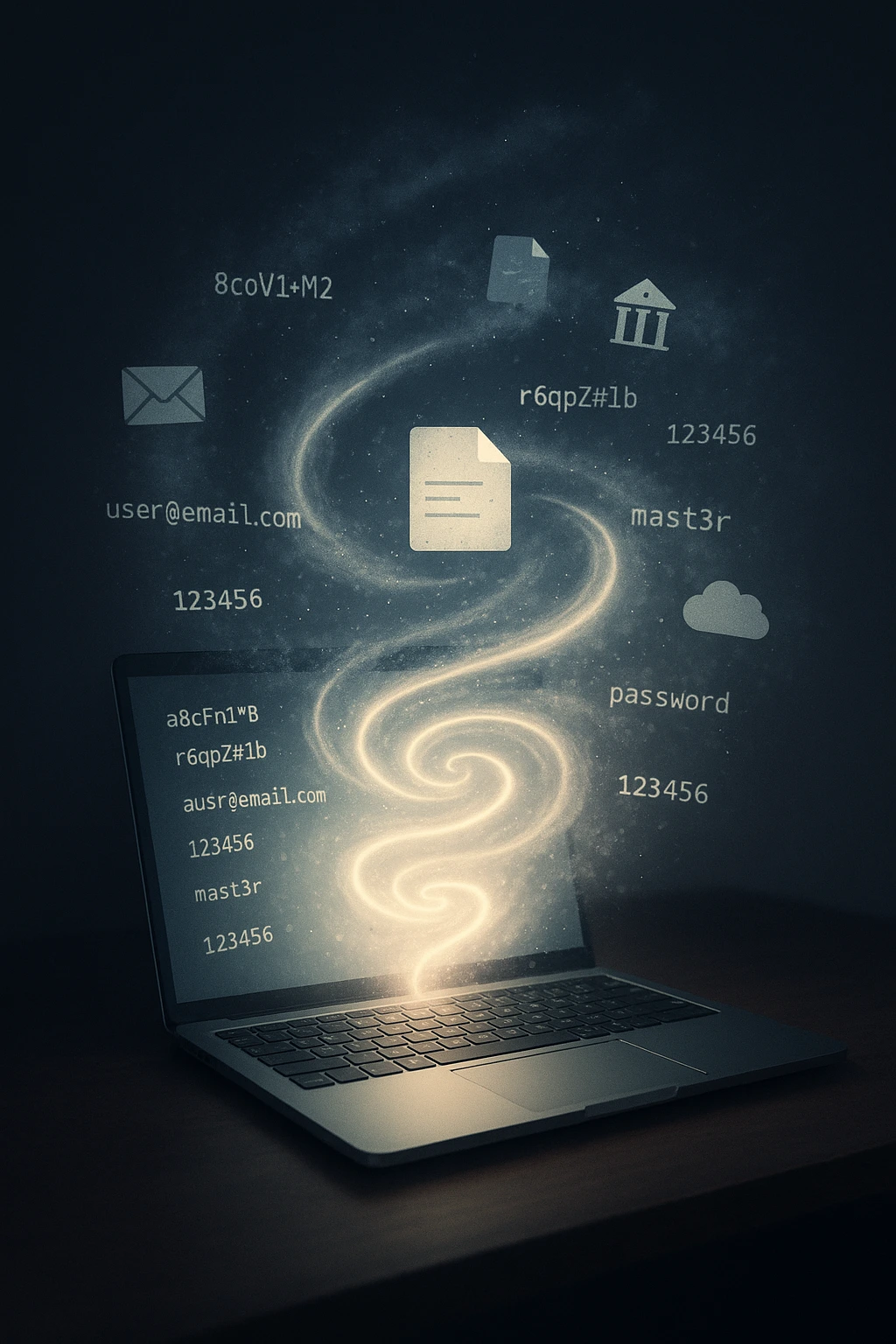184 Million Passwords Leaked — The File That Should Not Have Existed
A mirror. A warning. A call to remember what digital responsibility means.
What Happened?
No encryption. No password protection. No obscurity.
A file containing 184 million account credentials was found — exposed, searchable, and downloadable by anyone on the open web.

Discovered by cybersecurity researcher Jeremiah Fowler, the file included:
- Email addresses
- Usernames
- Plain text passwords
- Access details to:
- Microsoft
- Apple
- Online banking platforms
- Government portals
- Healthcare and identity systems
This wasn’t behind a login page. It wasn’t buried in the dark web. It was a plain text file — accessible through nothing more than a browser and curiosity.
Where Did It Come From?
Fowler’s analysis points to a class of malware known as an infostealer.
Infostealers operate quietly on infected devices — collecting everything from saved logins and cookies to browser autofill data and cryptocurrency wallets.

This data is usually:
- Sold in black markets
- Collected for credential-stuffing attacks
- Used to gain deeper access into systems and networks
But this time, the data wasn’t being sold.
It wasn’t encrypted.
It was dumped — carelessly or intentionally — into a public corner of the internet.
The hosting provider removed the file… but did not share who uploaded it.
Was the Data Real?
Yes.
Fowler reached out to a sample of exposed individuals. Many confirmed their credentials were valid.
This was not recycled breach data. This was current, usable, active. A real-world breach — laid bare.
What Are the Risks If You Were in the File?
This breach is more than exposure. It’s a cascade — a ripple of consequences moving faster than most people can react.

Even if your details weren’t in this file, the methods behind it are a mirror of how digital life can unravel when no one is watching.
Here’s how this plays out:
1. Credential Stuffing
Attackers don’t guess passwords anymore. They recycle what’s already been leaked.
With tools that test thousands of credentials across hundreds of platforms, a single reused password can become a skeleton key to:
- Your work email
- Your bank login
- Your social media presence
- Your cloud drives
One weak point = full breach.
2. Account Takeover
With access to your real email and password, attackers can:
- Lock you out of your own accounts
- Impersonate you
- Scam your friends or colleagues
- Access sensitive or personal data
For a business? They can impersonate leadership — and trigger internal transfers or HR requests.
3. Business Espionage & Ransomware
Fowler’s discovery included business logins — not just personal ones.
This is cybercriminal gold.
It opens the door to:
- Internal document theft
- Ransomware deployment
- Access resale to competitors or threat actors
One exposed CFO inbox? It can bring down a board
4. Government & Critical Systems Risk
Credentials to national portals, regional systems, and admin accounts were visible.
This isn’t just a privacy issue.
This is field vulnerability at scale:
- Procurement systems
- Tax data
- ID verification networks
- Citizen record portals
These are foundations. When they crack, democracy stutters.
5. Phishing & Tailored Deception
Even basic emails can become weapons. Leaked emails allow for:
- Custom phishing campaigns
- Reconstructed trust exploits
- Identity-based deception
This is no longer guesswork. It’s reconstruction of trust — used against you.
What You Can Do (Now and Going Forward)

This breach is not just an event.
It’s a signal.
You can’t undo the exposure — but you can reduce its impact, and prevent the next one.
1. Change Your Passwords Immediately
Start with:
- Cloud services
- Banking
- Work accounts
If they were reused or exposed, rotate them now.
2. Never Reuse Passwords
Every account must have a unique passphrase.
Why? Because the breach isn't the problem — reuse is.
3. Use a Password Manager
- Let it generate strong, unguessable credentials
- Store them securely
- Sync them across devices — encrypted, not emailed to yourself
4. Enable Multi-Factor Authentication (MFA)
A second layer — like a mobile app or token — can stop 99% of account takeovers.
If your service offers it, turn it on now.
5. Check if Your Info Has Been Leaked
Use trusted tools like:
HaveIBeenPwned.com
If your email appears, change all associated credentials — especially ones you’ve reused.
6. Enable Login Alerts
Many platforms can notify you when:
- A new device logs in
- An unrecognized IP connects
- Your password is changed
Turn those alerts on.
Respond to them immediately.
7. Install Real Security Software
Infostealers like the one that fed this breach are often silent.
Use a good endpoint protection suite.
Keep it updated.
Even a free scanner can make the difference between knowing… or never knowing.
Final Breath Reflection
This wasn’t just about data.
This was about trust — broken by convenience, neglected by process, forgotten by design.
Let this breach serve as:
• A field awakening
• A mirror to how we treat digital life
• A reminder to treat passwords like doorways, not tokens
From enterprises to individuals, freelancers to governments —cyber-security is now collective stewardship.
One careless upload exposed 184 million passwords.
But one intentional action — taken today — can protect what’s next. Don’t wait for another breach.
Don’t wait for permission.
Don’t wait for the field to fracture again.
Begin your response now —
With truth,
With integrity,
With care.


Categories